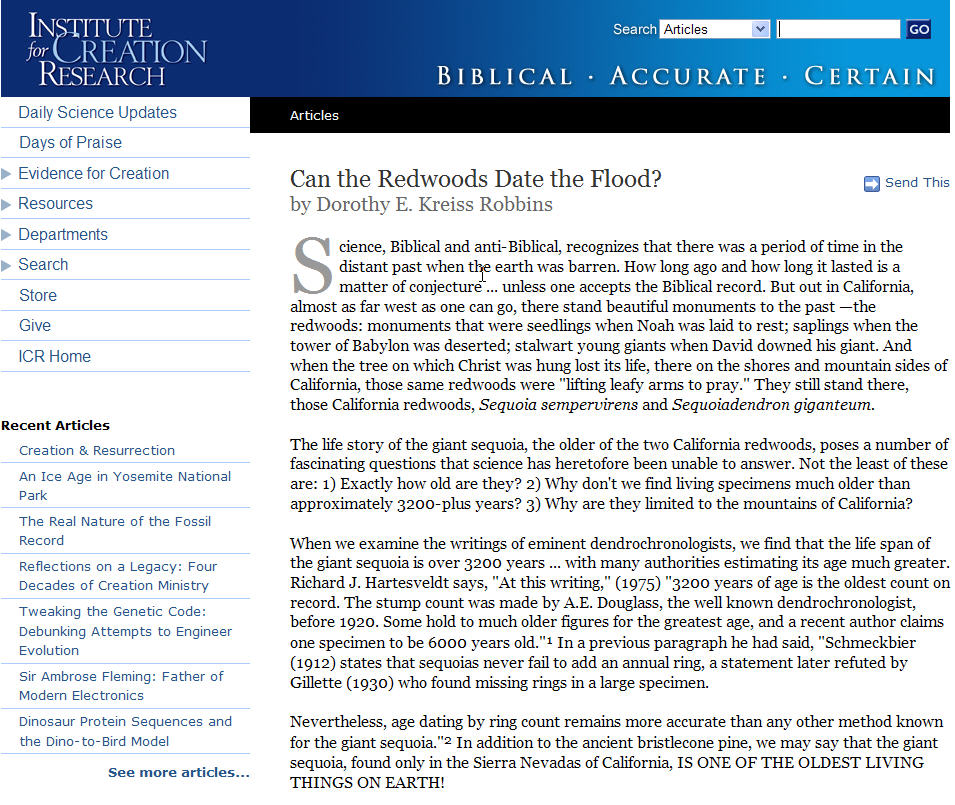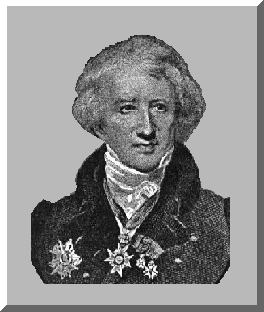
In 1654, Archbishop Usher (Ireland), based on genealogy in Bible, determined that Earth was created October 26, 4004 BC, 9:00am (PST). Therefore, the Earth was 6000 years old.
|

How Old is the Earth?
Commense sense methods?
A French scholar, Bernard Palissy who lived from 1510-1589 believed the Earth was much older
based on his observations that rain, wind, and tides were the cause for much of the present-day
appearance of the Earth. He wrote that, these forces could not work over such a short period of
time to produce the changes.
Palissy also rejected the idea that the biblical flood could have deposited all
fossils throughout the world, even on the highest mountaintops. But this stance
put him in a shaky position because the fossil shells he found well above sea level resembled ocean
- not freshwater - species.  How could this be?
How could this be?
As a Hugenot,he was imprisoned off and on for his Calvinist beliefs. After two especially difficult years of imprisonment, he died in 1590.
Categories of Geological Ideas:
Catastrophism:
Abraham Gottlob Werner: (1750-1817)
German geologist who founded the
Neptunist school, which proclaimed the
aqueous origin of all rocks, in opposition to
the Plutonists, or Vulcanists, who argued
that granite and many other rocks were of
igneous origin.
In the 18th century, rocks were explained in terms of the biblical flood, and were
classified into three categories:
 Note that
centuries of observations showed that volcanoes issue forth "liquid rock" which cools
and solidifies
Note that
centuries of observations showed that volcanoes issue forth "liquid rock" which cools
and solidifies
 |
Why has not anyone seen that fossils alone gave birth to a theory about the formation of the earth, that without them, no one would have ever dreamed that there were successive epochs in the formation of the globe. |
"We have monuments taken from the bosom of the Earth, especially from the bottom of coal and slate mines, that demonstrate to us that some of the fish and plants that these materials contain do not belong to species currently existing."
He contributed an immense amount of research in vertebrate and invertebrate zoology and paleontology, and also wrote and lectured on the history of science.
Cuvier's Scientific Thought
Cuvier saw organisms as integrated wholes, in which each part's form and function were integrated into the entire body. No part could be modified without impairing this functional integration:
. .. the component parts of each must be so arranged as to render possible the whole living being, not only with regard to itself, but to its surrounding relations, and the analysis of these conditions frequently leads to general laws, as demonstrable as those which are derived from calculation or experiment.Cuvier did not believe in organic evolution, for any change in an organism's anatomy would have rendered it unable to survive. This is a logical argument that Aristotle might have made if asked the question - do species evolve? No since, organisms are functional wholes - any change in one part would destroy the delicate balance.
Cuvier's insistence on the functional integration of organisms led him to classify animals into four "branches," or embranchements: Vertebrata, Articulata (arthropods and segmented worms), Mollusca (which at the time meant all other soft, bilaterally symmetrical invertebrates), and Radiata (cnidarians and echinoderms).
For Cuvier, these embranchements were fundamentally different from each other and could not be connected by any evolutionary transformation. Any similarities between organisms were due to common functions, not to common ancestry: function determines form, form does not determine function.
It is these emerging ideas of function and form that will underlie some of the scientific criticism of Darwin's theory that will be coming in about 100 years. Common functions determine species similarities - not common ancestry!
What had happened to the great beasts of the past? Cuvier believed that the Earth was immensely old, and that for most of its history conditions had been more or less like those of the present. However, periodic "revolutions", or catastrophes (a word which Cuvier avoided because of its quasi-supernatural overtones) had befallen the Earth; each one wiped out a number of species. Cuvier regarded these "revolutions" as events with natural causes, and considered their causes and natures to be an important geological problem. This led to the theory of catastrophism, that the Earth was shaped by series of giant disasters. If the Earth is young and species go extinct then many of these disasters have to fit into a short time scale. In general, this idea of castrophism will be discarded as Junk Science, not applicable to what the Earth really does.
Can we find any modern day validation of this theory?
In 1770's, James Hutton, Father of Geology (Scotland, 1726-1797) published `Theory of the Earth' in 1785. Demonstrated that Hadrian's Wall was built by Romans and that after 1500 years there was no change. Thus, he suspected that Earth was much older than 6000 years.
This is the theory of uniformitarianism, that slow but steady processes shape the landforms on the Earth. The physical and chemical laws that govern nature are uniform.
According to this theory, there were essentially three stages that form a complete cycle:
The process then started all over again, continuously regenerating the Earth's surface over countless ages, maintaining an environment capable of supporting living animals and plants
Is this original idea of continuous regeneration inconsistent with previous notions about the interaction between God and Nature?
Hutton writes:
the Earth functions as a machine whose purpose is to sustain life
Does this sound familiar?
Gradualism
By this time, it is known that the earth has ice ages
In the mid 1800's, Scottish geoglist Sir Charles Lyell expanded on uniformitarianism to develop gradualism, the view that all features of the Earth's surface are produced by physical, chemical, and biological processes through long periods of geological time.
The frontispiece to Lyell's Principles of Geology showed the Temple of Serapis in Italy. At the tops of the stone pillars were dark bands, made of holes drilled by mollusks. Lyell showed the picture to make a point: The pillars had been constructed above ground, l ater been submerged under water, and finally lifted above sea level. Considering these changes had happened during recorded history, the same geological processes could, during prehistoric times, build mountains, valleys, canyons, and all the other features we see today. His system was based on two propositions: the causes of geologic change operating include all the causes that have acted from the earliest time; and these causes have always operated at the same average levels of energy. These two propositions add up to a "steady-state" theory of the Earth in which, at any time, the geological structure of the earth represents average conditions.
Lyell's position suggested that the world had always been (roughly) similar to its current state. In particular, Lyell believed that the species composition of the world remained unchanged, with at least some members of all classes of organisms existing throughout the history of the earth.
Darwin read Lyell's Principles of Geology and came to accept Lyell's view that long-term geological processes were responsible for shaping the earth's surface in a gradual manner.
How does this help fortify or motivate
Darwin's position on the Origin of Species?